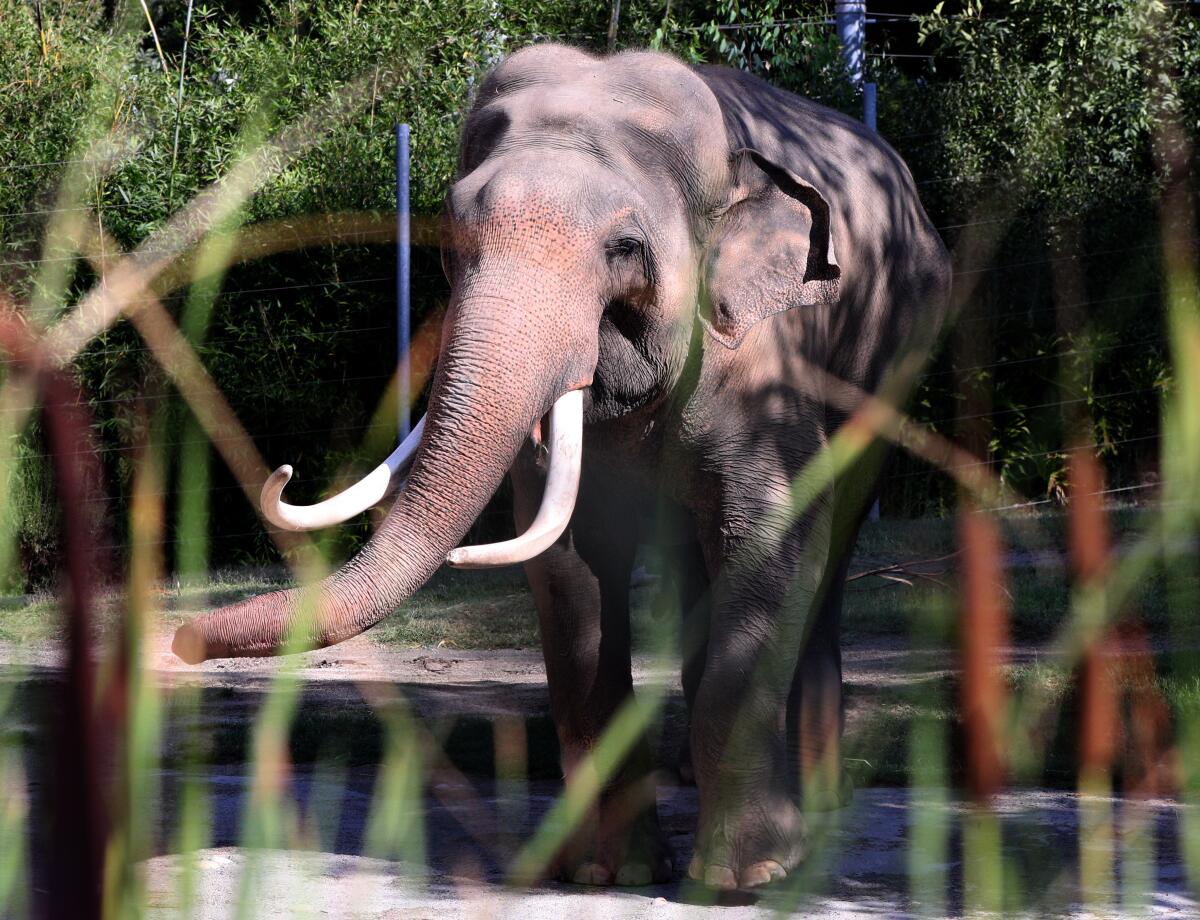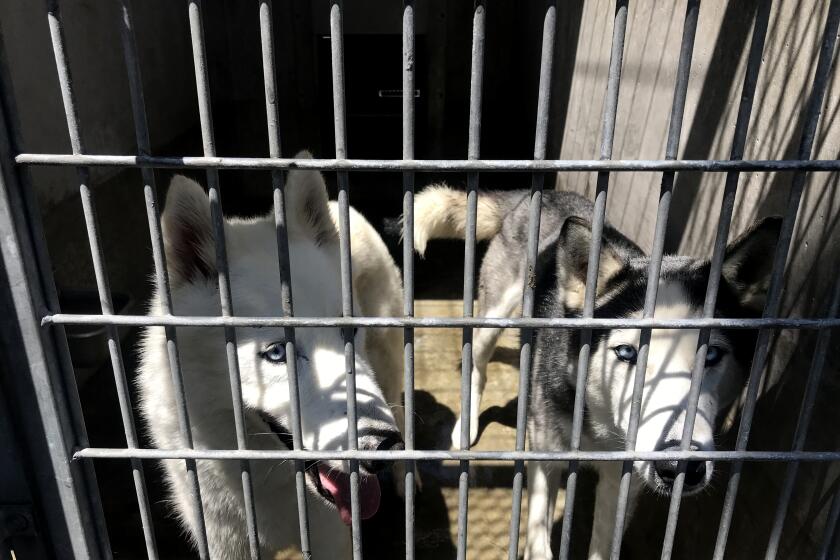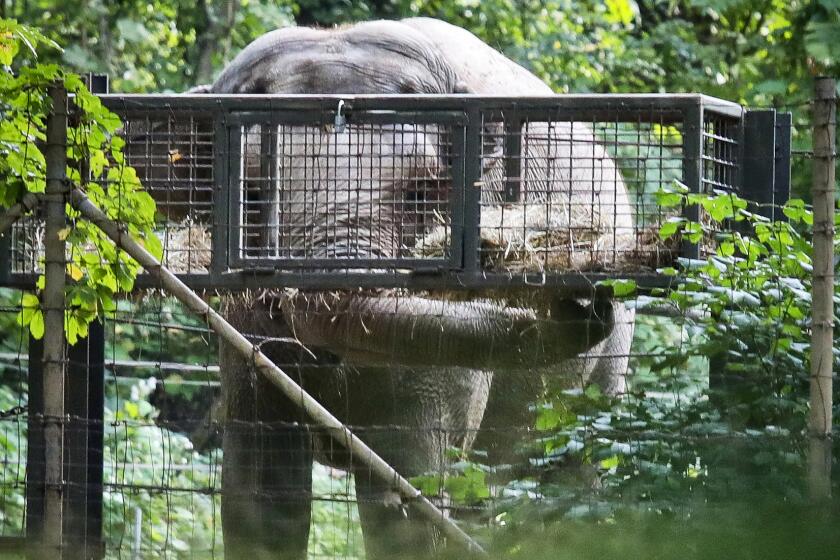Editorial: Free Billy! L.A. Zoo’s longtime elephant has earned retirement

- Share via
Billy, an Asian elephant bull, has spent most of his 37 years at the Los Angeles Zoo fascinating visitors with his long ivory tusks and worrying animal welfare advocates with his frequent head bobbing. While zoo officials have maintained it’s nothing more than a harmless habit — sometimes done when he anticipates keepers coming to feed or exercise him — various animal experts, including veterinarians, say it’s a sign of stress and trauma.
The issue of whether any zoo can successfully care for elephants, the largest land mammal, and capable of walking miles a day for food and shelter, has been debated for years. Some zoos have retired their elephants, letting them live out the rest of their lives at a sanctuary with acres of land. Others, including the L.A. Zoo, kept their pachyderms but improved their living conditions. The L.A. Zoo spent $42 million building the larger Elephants of Asia exhibit that offers its four Asian elephants 3.6 acres of space, divided into four yards. The former zoo director said the L.A. Zoo elephant exhibit is in the top 10 nationwide in terms of size.
Over the years, City Council members, animal experts and advocates have argued that the L.A. Zoo is no place for elephants and that Billy, the seemingly most stressed of the zoo herd, should be retired to a sanctuary. One private citizen waged a decade-long legal battle to get the zoo to stop elephant keeping. Although the judge in the case criticized the zoo as “not a happy place for elephants” and ordered changes in its care, that ruling was eventually thrown out by the California Supreme Court. Zoo officials have said they still follow the judge’s orders concerning care.
City shelters are understaffed and underfunded. They need long-term solutions But right now, dogs need to be let out for walks and for play.
On Tuesday, a City Council committee voted in favor of relocating Billy to a sanctuary. The full City Council should now do the same, and instruct the zoo to start the process by studying how and where.
This isn’t about accusing the zoo of mistreatment or negligence, but a recognition of the zoo’s inherent shortcomings in providing everything this particular elephant needs; a larger enclosure hasn’t alleviated Billy’s head-bobbing behavior.
For years, Billy was kept apart from the zoo’s three female Asian elephants, so he had no elephants to socialize with. (Bulls don’t stay with female herds after they mature, but studies in the wild have shown they are more social than was once thought.) In the last few years, the zoo staff has let him mingle with the females, and on those occasions they have seen a significant reduction in his head bobbing, according to Denise Verret, the director of the L.A. Zoo for the last 3½ years, and deputy director for nearly two decades previously. Those observations of Billy are encouraging but not a reason enough to keep him at the zoo.
A new case in California will test the theory that captive elephants should be allowed to petition for their liberty.
Retirement would also mean that Billy will no longer be subject to invasive attempts to retrieve his semen for artificial insemination of female elephants in other zoos. (The L.A. Zoo’s females — Shaunzi, 51; Tina, 56; and Jewel, 60— are beyond their breeding years.) Those attempts were unsuccessful and according to zoo officials were stopped eight years ago.
Verret says she is open to moving Billy to a new place where he can thrive, although she has made it clear she would prefer a zoo accredited by the Assn. of Zoos and Aquariums, the trade organization that represents and accredits zoos in North America. Some sanctuaries, including the Elephant Sanctuary in Tennessee, are accredited, although most are not open to the public. But Verret says, “We never stop considering all the opportunities there are to enhance Billy’s welfare — including other places where his welfare might be improved.”
Good. Verret and her staff should start doing that by looking into sanctuaries. Finding a suitable one will be a months-long process. Preparing him for a move could take months as well. There are only a handful in the U.S. that can care for elephants. How much space the sanctuary has, how many other Asian elephants are there and how much care will be provided are all issues that will need to be addressed.
Recovering from foot surgery, the 47-year-old Asian elephant is one popular pachyderm on her leisurely morning walks at the Los Angeles Zoo.
Can the sanctuary offer terrain that will be softer and better for Billy’s feet than the exhibit at the zoo? Even the ground in the L.A. Zoo exhibit, which is rototilled regularly to make it softer to walk on, gets hard in places after heavy elephants have repeatedly trodden on it. Captive elephants are at risk for debilitating foot and joint problems, and Billy has had cracks in his nails, according to Philip Ensley, a former veterinarian for three decades at the San Diego Zoo and San Diego Safari Park who has written reports and given trial testimony on the health of elephants in various zoos.
Billy has put in more than three decades of service at the L.A. Zoo. He has earned retirement in a place where he has more space to roam and a less stressful life.
More to Read
A cure for the common opinion
Get thought-provoking perspectives with our weekly newsletter.
You may occasionally receive promotional content from the Los Angeles Times.












